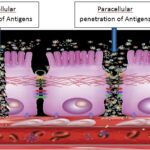The conventional approach to treating hypothyroidism is the use of synthetic drugs. However the long-term use of these synthetic drugs such as Synthroidtm, is associated with a depletion of tissue iodine levels. It would only make sense then to recommend that iodine/iodide should always be used with these drugs.
The work of Drs. Abraham and Brownstein has shown that iodine, the universal nutrient, has at least 5 major functions overall:
- Weight Regulation, Hormonal Function and Energy
Thyroid hormones must have adequate iodine to function properly. These hormones that use iodine, simulate an increase in the number and size of the mitochondria – the cellular site for the production of energy. This will directly affect the overall metabolic rate in the body. But the thyroid hormone is also involved with the metabolism of fats and carbohydrates, heart rate and the strength of the heartbeat, muscle and gastrointestinal function, digestion, gene transcription and directly influences other endocrine hormones. In essence most every area of the body is affected by our thyroid function or lack thereof.
Without sufficient iodine, thyroid hormones will dysfunction, which leads to a deficient metabolism and inadequate fat burning for energy and heat. In addition it will be accompanied by a difficulty losing or maintaining previously lost weight. No surprise to anyone with the ability to see, we have an epidemic of obesity in this country. One of the reasons for this is that iodine is crucial for metabolism and weight loss. Iodine and other toxic halogens will store in our fat cells and when the other halogens, like chlorine are excessive, they inhibit the function of iodine which facilitates the release of fat from the cell. Do keep in mind, however, that iodine is no magic pill in your weight loss endeavor, if you are not following a correct eating and exercising program.
- Immune Function
Individuals with inadequate iodine levels are prone to infections of all types. You remember putting iodine on an open wound? Well, it naturally has anti-bacterial, anti-viral and even anti-parasitic properties. In sufficient amounts it has been found to induce a destruction of cancer cells and iodine deficiency is associated with increased risk for cancers and cysts. Finally, one of iodine’s least appreciated roles is its ability to act as a natural detoxifier of mercury, fluorides, chlorides and bromides.
- Fertility and Menstrual Function
Probably due to its concentration and role in the thyroid, breasts and ovaries, iodine deficiency has long been associated with difficulty in conceiving. But it is more commonly involved with menstrual irregularities, fibrocystic breasts, ovarian cysts and possibly early menopause and prostatitis in men. Dr. Brownstein believes that iodine deficiency is a major cause of breast cancer and other diseases of the reproductive organs.
- Brain Development and Function
Iodine and thyroid hormone deficiency will have a marked impact on intelligence and memory and is likely to play a significant role in learning disabilities and attention deficit disorders. Iodine is also found in the eye and in the substantia nigra area of the brain – the area associated with Parkinson’s disease. Even breast milk has (or is supposed to have) high amounts of iodine since this nutrient is very important for brain and nervous system development in children.
- Heart and Arrhythmias
Like underactive thyroid, heart arrhythmias are nearly epidemic. Adequate iodine levels are necessary for a smooth regular heartbeat. One of the more common drugs used to treat arrhythmia, Amiodarone, is primarily iodine in a sustained-release, but toxic form. But caution here – it is not safe to use iodine along with Amiodarone – do consult with your physician first.
It was in the 1920s that iodine was first added to table salt. As noted earlier, this practice gave a false sense of iodine sufficiency. The medical community relied 100% on iodized salt instead of the previously used forms of iodine and iodide found in Lugol Solution (a 5% solution of 50mg iodine and 100mg potassium iodide per milliliter). Rarely used since the 1950s, Lugol Solution provided twice the amount of iodine present in table salt (which also has none of the important potassium iodide form), and none of the competing chlorine ions.
So instead of adding or re-supplying the iodine, physicians relied on synthetic drugs (such as Synthroid) to treat patients with thyroid deficiency. However there are many individuals who have 50 –80% or more of the symptoms of thyroid deficiency but have “normal” thyroid hormone levels, and none of these receive any treatment at all. This is the classic Wilson’s Syndrome. Those suffering with this syndrome always have low body temperature and have difficulty staying warm. Which is why the late, Broda Barnes, MD, always found the basal body temperature (97.8 or lower suggestive of hypothyroid) a better indicator of thyroid function than that of blood thyroid levels. Yet there are a number of practitioners who feel they could substantially improve (if not cure) these Wilson’s Syndrome individuals as well as a very high percentage of those with classical hypothyroid or hyperthyroid conditions by normalizing iodine levels.
The thyroid gland, fat tissue, and some other vital organs appear to be repositories of toxic metals, such as mercury, along with other toxic contaminants. When this occurs, organ dysfunction is likely. One of the benefits of iodine is that it facilitates increased removal and excretion of poisons from these tissues. In addition it enhances the liver’s detoxification mechanisms. Perhaps this is why Dr. Abraham discovered that even patients with a complete thyroidectomy benefited from iodine therapy. He found that some of his patients who achieved iodine sufficiency were able to resolve diabetes without insulin and to normalize blood pressure with a reduction or elimination of their medication.
Testing for Iodine Sufficiency – home test
Here is a simple test to determine whether an iodine deficiency exists. From a bottle of tincture of iodine (drug stores carry these), paint a 2 inch square area on your inner arm. If it disappears in less than 8 hours, iodine need is indicated.
Testing for Iodine Sufficiency – lab test
A more definitive way of testing for iodine deficiency uses a pre and post urine evaluation. Testing first involves collecting urine immediately upon arising for the spot or pre-test. After this collection, 50 mg. of potassium iodide/iodine is ingested and then all urine passed in the next 24 hours is collected and measured, with a sample sent to the lab for analysis. In essence the more iodine found in the urine, the less the body needs. Likewise, the less of the ingested iodine sample found in the urine, the more the body wanted the iodine and the greater the deficiency and need for supplementation. If the body has sufficient iodine at least 90% will be excreted in the urine. Supplementation is normally done rather gradually as iodine can mobilize toxic metals and other toxic poisons from storage sites in sufficient quantities to provoke symptoms. Re-testing should be repeated no later than 3-4 months to ensure successful therapeutic results.
In regards to supplementation, keep in mind that nearly all available supplements found in health food stores or pharmacies contain only the iodide form of iodine. However, Drs. Brownstein, Flechas, Abraham and others found that to successfully improve iodine levels in the body, it was necessary to include both the iodide (reduced) and iodine (oxidized) forms because the body needs both forms. The iodine content of food is extremely variable, but the richest food sources all come from the ocean – Kelp/seaweed, sea vegetables, sea bass, cod, haddock, and ocean perch. Several of these may be a significant source of mercury as well.
It is highly unlikely for excess iodine intake to occur when following the recommended dosage schedule and following urine testing results. But in very rare cases of excess, individuals may experience a metallic taste, increased salivation, sinus headache, nervousness, palpitations and a sense of fever, all easily rectified by adjusting the amount of iodine. It should be noted, however, that some symptoms thought to be due to excess iodine, may in fact be the forced excretion of those toxic metals and compounds lodged in the tissues.
Summary
When you put the whole picture together and compare our country with Japan, you have to ask, “What is the consequence of the Japanese ingesting many, many times the amount of iodine as the average American?” And the answer is (at least in part), a much leaner population, a significantly lower rate of breast cancer, a lower infant mortality rate and a much better life expectancy. Of course there are other factors but let us not forget, Iodine is a part of that improved health.
The need is to achieve whole body sufficiency of iodine. When this state is reached it correlates well with overall well being. Energy levels go up, sleep improves and less is required, elimination is better and skin complexion is much healthier. The following results have been noted by one doctor:
* Goiters reduced/eliminated
* Elevated TSH readings lowered to normal
* Thyroid gland excretes toxins and other heavy metals
* Improvement of the liver’s detoxification mechanism
* Improvement in weight management
* Improved blood sugar and blood pressure regulation
* Improved menopausal symptoms
* Breast tissue normalization including fibrocystic breast disease
* Ovary tissue normalization of polycystic ovary syndrome
* Less brain fog and clearer thinking
* Heart function improvement with reduced arrhythmias
* Reduction of thyroid and breast cancer rates



 Cyrex Array 3: Wheat/Gluten Proteome Sensitivity and Autoimmunity
Cyrex Array 3: Wheat/Gluten Proteome Sensitivity and Autoimmunity